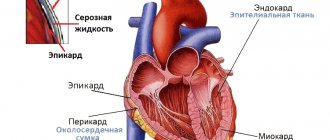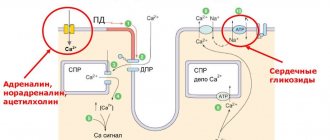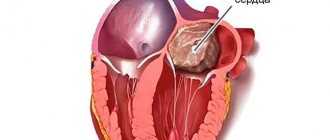What you need to know about papillary fibroelastoma
- Sometimes it is determined by chance during ECHO-CG, cardiac surgery or autopsy.
- Second most common benign primary cardiac tumor (approximately 10%)
- Men and women are affected approximately equally
- The average age at diagnosis of a benign primary heart tumor is 60 years.
- The etiology of papillary fibroblastoma is unclear
- 90% of fibroelastomas originate from the heart valves: aortic (29%), mitral (25%), pulmonary (13%) and tricuspid (17%).
Diagnostic methods
The most accessible diagnosis of myxoma is using ultrasound.
Ultrasound allows you to determine the size and location of the tumor, the degree of mobility. For better visibility and clearer parameters use:
- ultrasound probing through the chest;
- transesophageal echocardiography - a probe is inserted into the esophagus to the level of the heart chambers, helping to detect tumors measuring 1-3 mm in diameter.
Magnetic resonance and computed tomography will help in diagnosis if the ultrasound conclusion does not clearly present the picture.
Studies can reveal growth into the wall of the heart (a distinctive property of malignant tumors); possible diagnosis is limited to tumor growth with a diameter of 5 to 10 mm
Coronary angiography is mandatory in preparation for surgery for people over 40 years of age.
Cardiac catheterization is necessary to remove tumor tissue for biopsy to confirm whether the tumor is benign.
An ECG determines the type of arrhythmia and signs of hypertrophy of individual chambers.
A chest x-ray reveals an enlarged heart shadow and heterogeneity of the mass.
Blood tests for biochemical tests, electrolytes, troponin help resolve issues of differential diagnosis. Cardiac myxoma must be distinguished from other types of pulmonary hypertension, valve stenosis and insufficiency, and mitral regurgitation.
Which method of diagnosing fibroelastoma to choose: MRI, CT, ECHO-CG, angiography
Selection method
- ECHO-KG.
What will a chest x-ray and CT scan show?
- Chest radiography usually does not provide additional information for papillary fibroblastoma
- The formation can be detected with contrast-enhanced MSCT, under ECG control
- CT can exclude the presence of metastases in doubtful differential diagnostic cases.
Why is cardiac ultrasound performed for fibroelastoma?
- May demonstrate a pedunculated, mobile hyperechoic tumor
- Poorly demarcated from surrounding blood
- Fibroblastoma has a “sea algae” appearance, more than 4 cm in diameter
- Rarely shows calcifications
- Thrombotic deposits may be detected.
In what cases is cardiac MRI performed for papillary fibroelastoma?
- Benign cardiac tumors have low T1-weighted signal intensity and enhancement after Gd-DTPA administration
- Depending on the location on the heart valves, a benign cardiac tumor may be detected by cine-MPT with high temporal resolution.
T1-weighted TSE sequence with adipose tissue suppression after Gd-DTPA administration to a 42-year-old man who suffered an embolic transient ischemic attack. Image through the plane of the LV outflow tract demonstrates an enhanced mass on the left coronary valve leaflet (arrow). Histological examination after valve replacement confirms fibroelastoma.
Manifestations of heart tumors
Most heart tumors have similar symptoms associated with the presence of additional tissue in the organ chamber, disruption of blood flow through the valve openings, and damage to the conduction system. Clinical features are associated with the location of the tumor inside, outside the heart, in the thickness of the myocardium or on the valve leaflets. The most characteristic signs of pathology:
- Pain and feeling of heaviness in the chest;
- Dyspnea;
- Edema;
- Tachycardia, feeling of rhythm interruptions;
- Skin cyanosis.
Malignant neoplasms tend to lead to general changes - weight loss, fever, lack of appetite, pain in bones and joints, and possibly a skin rash.
Neoplasms located outside the heart may cause shortness of breath and chest pain. As they grow, they impair the mobility of the organ, preventing the proper emptying and filling of its chambers. Possible decay and bleeding is associated with the development of cardiac tamponade - a condition in which the cavity of the heart sac is filled with blood, blocking the contractions of the organ; the result of tamponade is asystole (cardiac arrest) and death.
Compression of large vascular trunks by a tumor manifests itself as:
- Swelling of the face and upper half of the body due to compression of the superior vena cava;
- Swelling of the legs and venous stagnation in the internal organs due to compression of the inferior vena cava.
Tumors growing inside the myocardium affect the fibers of the conduction system, so heart rhythm disturbances will be the main symptoms. Patients complain of rapid heartbeat during tachycardia; in the case of blockades, interruptions and a feeling of freezing in the chest appear. In addition to arrhythmias, symptoms of heart failure increase, shortness of breath, weakness, swelling appear, and the liver enlarges.
Tumors located inside the chambers of the heart cause disruption of blood circulation in the atria, ventricles and large vessels, prevent the filling of the heart chamber or its emptying, and can close the valve opening, simulating stenosis. The main manifestation of such tumors is considered to be rapidly progressing heart failure.
When myxoma of the left atrium fills this chamber, it manifests itself as severe shortness of breath, fainting, and chest pain. A characteristic sign of it will be increasing heart failure that does not respond to conservative treatment. Sudden death is possible if the mitral valve is obstructed (closed) by myxoma. It is important that the symptoms worsen when changing body position.
If the neoplasm affects the valves, then signs of their stenosis or insufficiency arise - stagnation in the pulmonary circulation with shortness of breath, pulmonary edema, and a tendency to inflammatory processes in the respiratory system; in large cases - with liver enlargement, edema, cyanosis.
Embolism by tumor cells is very characteristic and especially dangerous in valvular localization of neoplasia. When the mitral or aortic valve is damaged, cell conglomerates enter a large circle with arterial blood, blocking the vessels of the heart, brain, kidneys, legs, etc. Clinically, this will manifest itself as a stroke, myocardial infarction, or ischemia of the limbs.
If tumor emboli enter the bloodstream from the right side of the heart, the pulmonary artery and its branches become blocked, which is manifested by shortness of breath, increased pressure in the pulmonary circle, and dilation of the right half of the heart.
If blood flow through the main artery is disrupted, death most often occurs from acute pulmonary heart failure. Considering the nonspecificity of symptoms, which can occur in a number of other heart diseases, diagnosing tumors of this organ is not an easy task.
If tumor growth is likely, it is most advisable to send the patient for an ultrasound; if necessary, CT and MSCT, probing, radioisotope or radiocontrast examination of the cavities of the heart are performed. An ECG with a tumor does not have characteristic changes; it records arrhythmias, conduction disturbances, signs of stress on the parts of the heart, etc., which occurs in a wide variety of cardiac pathologies.
What pathologies have symptoms similar to papillary fibroelastoma
Thrombosis
— Fibroelastoma is depicted by ECHO-CG as a pedunculated formation, with its base on the heart valve
- Poorly distinguishable from blood
Myxoma
— Often hyperintense on contrast-enhanced T2-weighted image
- May be indistinguishable from papillary fibroelastoma
Bacterial vegetation
— Destruction of the affected valve (regurgitation, heart murmur)
— Fever
Classification
All tumor growths of the heart are divided into primary and secondary (metastatic). In turn, primary growths can be benign or malignant.
Benign primary tumor
Such formations occur in 75% of all cases of heart tumors. According to their location and histological structure, they are divided into several types.
Myxoma
This type of primary heart tumor is found in every second patient. The neoplasm is formed from connective tissue and contains a large amount of mucus. It has the appearance of a pedunculated polyp. The size of myxoma can vary from 1 to 15 cm, and the weight reaches 230 grams.
The structure of the nodes of this type of pathology consists of a large number of blood vessels. Hemorrhages and necrosis often occur.
Most often, myxoma is located in the left atrium. Sometimes the valves and ventricles are affected.
The disease usually affects women of pre-retirement age. In men, a high probability of pathology occurs in case of poor heredity.
Rhabdomyoma
The tumor is most common among infants and children with tuberous sclerosis.
On this topic
- Cardio-oncology
5 Symptoms and Signs of Heart Cancer
- Natalya Gennadievna Butsyk
- December 18, 2020
Rhabdomyomas are located in the septum or wall of the left ventricle and lead to disruption of the conduction function of the heart. Most often, neoplasms are multiple in nature. They are formed from striated myocardial muscles and are capable of growing more than 10 cm in diameter.
When examined macroscopically, rhabdiomas take the form of white, hard, lobular nodules or infiltrate. With age, such tumors can regress on their own.
Papillary fibroelastoma
The tumor is localized in any area of the heart. Most often the mitral and aortic valves are affected.
Outwardly, it looks like a trunk with branches, its dimensions do not exceed 1 cm. Fibroelastoma consists of connective tissues without blood vessels, has a light shade and elastic consistency.
Due to the mobility of the growth, fragmentation sometimes occurs, leading to the sudden death of the sick person.
Tumors are detected in men and women of various age groups.
Fibroma
Often the tumor forms in the ventricle or heart septum. This single growth of dense consistency and light shade can grow up to 5-10 cm in diameter.
On this topic
- Cardio-oncology
What symptoms can you use to identify cardiac sarcoma?
- Natalya Gennadievna Butsyk
- December 18, 2020
The tumor is clearly separated from surrounding tissues, but is prone to invasive growth.
Multiple foci of calcification and cystic degeneration are observed on the surface of the fibroma.
Usually the disease is diagnosed in children during the period of active growth.
Other rarer types of benign cardiac tumors include lipoma, pericardial cyst and hemangioma.
Malignant primary tumor
The most common type of this group of diseases is sarcoma. It has several varieties, differing in type and histological structure. It is diagnosed equally often in middle-aged men and women. The right side of the heart is most often affected.
Sarcoma often leads to blockage of the valve opening, compression and local damage to blood vessels.
The tumor spreads in a short period of time, affecting any layers of the organ and nearby anatomical structures. Metastases are often found in the lungs, lymph nodes, mediastinum, and brain.
Angiosarcoma
Its development begins from vascular cells. The tumor is found in every third patient with primary cancerous tumors in the heart. Women get sick three times less often than men.
All parts of the organ are affected, but most often the right atrium.
In its form, angiosarcoma looks like a tuberous compaction, the cells of which are able to penetrate into neighboring tissues. When the growth is cut, traces of hemorrhage and necrosis are observed.
Fibroskarcoma
The tumor is formed from soft tissue cells and is found in people of any age. Externally, this formation looks like a dense node of gray or white color. In some cases, infiltrative growth may occur with the absence of clear boundaries of the pathological formation.
The disease has no specific symptoms. Patients usually develop heart failure.
Rhabdomyosarcoma
A malignant tumor is formed from damaged tissue of the heart muscles. The growth is small in size and soft in consistency, the boundaries are not blurred.
Rhabdomyosarcoma is found in males under 21 years of age.
Atypical cells have different shapes, structures and sizes. Their uncontrolled growth and division leads to the rapid spread of metastases. Often the tumor is combined with abnormalities in the development of the cardiovascular system.
Pericardial mesothelioma
This tumor can be benign or malignant. Its formation occurs in the pericardial sac from flat single-layer epithelium, which covers the serous membrane of the heart.
On this topic
- Cardio-oncology
Everything you need to know about vascular cancer
- Natalya Gennadievna Butsyk
- August 25, 2020
In some cases, the cancerous growth can completely cover the organ. Metastases spread through the lymphatic system.
The disease is most often diagnosed in men over 45 years of age.
Diagnostics
Since the clinical picture is nonspecific, additional research methods are needed to diagnose tumors.
ECG
By itself, it is not important for the diagnosis of tumors. However, the appearance of rhythm disturbances and changes in the amplitude of waves on repeated ECGs may indicate the growth of a primary tumor or metastatic damage to the heart.
Chest X-ray
May aid in the diagnosis of tumors extending beyond the epicardium. In these cases, a tumor is indicated by cardiomegaly, widening of the mediastinum, and uneven contours of the cardiac shadow. Sometimes areas of tumor calcification are visible. With large intracavitary tumors of the right or left parts of the heart, a depletion or enrichment of the pulmonary vascular pattern may be visible, respectively.
EchoCG
Almost always allows you to make a diagnosis. If there is a strong suspicion of a tumor or an unclear mass is detected on transthoracic echocardiography, transesophageal echocardiography is indicated. Its sensitivity and specificity are higher than transthoracic, especially for mass formations in the atria. Transesophageal echocardiography allows you to better examine the boundaries of the formation, cysts, areas of calcification, and see the stalk of the tumor.
Scintigraphy
Previously, equilibrium isotope ventriculography was used to detect tumors, but due to low resolution and low sensitivity, this method is no longer used in tumor diagnosis.
CT scan
especially electron beam, is often used in the diagnosis of cardiac tumors. It allows you to assess the size of the tumor, the extent of the lesion and the condition of the structures adjacent to the heart.
Magnetic resonance imaging
Like CT, it plays an important role in the diagnosis of heart tumors. It allows you to determine the size, shape and nature of the surface of the tumor, as well as its structure. MRI can distinguish a tumor from a blood clot.
Cardiac catheterization and X-ray contrast studies are usually not necessary. However, in some cases it is advisable to carry them out:
if non-invasive research methods are not informative
- to determine the source of blood supply to a presumably malignant tumor
- to assess valvular and coronary artery lesions
Because all this can affect surgical tactics.
The main danger of catheterization is the possibility of tumor embolism and thromboembolism. If a left atrial myxoma is suspected, transseptal catheterization is contraindicated, since myxomas very often attach to the fossa ovale and catheterization can lead to embolism.
Causes of a malignant heart tumor
As a primary tumor, heart cancer develops directly from the tissue of the heart muscle itself. But this happens in very rare cases.
Much more often the tumor has a secondary form of malignant pathology. From the affected organs, cancer cells travel through the blood to the heart. The cardiovascular system runs throughout the body, and this makes the path easier for metastases.
Malignant tumors localized in the gastrointestinal tract and pelvic organs can lead to rapid uncontrolled division of affected cells. As a result, metastases quickly reach new targets, which, unfortunately, includes the heart.
At present, all the causes of damage to the heart muscle by cancer cells are not yet fully known. But some of them include:
- surgery on the heart muscle due to injury or other reasons;
- blood clots;
- atherosclerosis of the brain and vascular system;
- hereditary predisposition by genotype;
- Constant stress and worry undermine the immune system and weaken the body.
Heart tumor: when is it necessary to sound the alarm?
The most terrible disease of any human organ is a tumor, benign or malignant. Heart tumors are quite rare, but still occur in oncological practice.
Classification and types of tumors
Neoplasms in the heart can affect both the pericardium and the tissue of the heart muscle itself. Such a pathology is not often found in oncology due to the good blood supply to the organ and the rapid metabolic process.
Heart tumors are: primary (develop from the myocardium itself) and secondary (formed from cancer cells coming to the heart through lymph and blood from organs with cancer).
Most primary formations are benign, but in 15% of cases malignant processes are also diagnosed.
8
24/7
Benign heart tumors include 7 types:
- Myxoma. Occurs in 78% of cases among all myocardial tumors. The tumor grows into the cavity of one of the atria. Myxoma is more often diagnosed in women during the postmenopausal period.
- Papillary fibroelastoma. A type of tumor that is quite common. The location is the papillae of the aortic or mitral valve. The specific location of the tumor prevents complete closure of the valve during ventricular contraction.
- Rhabdomyoma. The tumor is formed from cardiac muscle tissue. Occurs in 12% of cases. The location is the left ventricle. Provokes conduction disturbances in the heart muscle. More often diagnosed in children.
- Fibroids mainly affect the heart valves. It can provoke stenosis between the ventricle and the atrium, pericarditis.
- Lipoma. Neoplasm from adipose tissue cells. The location can be any part of the myocardium. Usually it does not manifest itself, but if it is large in size it can provoke disruptions in the functioning of the heart.
- Hemangioma. A tumor of the heart vessels, which is diagnosed very rarely. Does not affect the functioning of the myocardium if it does not grow into the sinus node. In such a case, the heart rhythm may become disrupted, and severe cases can lead to death.
- A teratoma is a cardiac cyst that develops from embryonic cells. The tumor can be located under the heart, on the side or above it.
Sarcomas are considered the only type of primary malignant tumors of the heart. It is divided into the following types:
- angiosarcoma: formed from cells of blood and lymph vessels, most often affects the right atrium, in most cases it is diagnosed in men;
- fibrosarcoma: develops from the soft tissue of the myocardium;
- liposarcoma: originates from a collection of cells of predominantly mesodermal origin (mesinchem);
- Rhabdomyosarcoma: forms in the striated muscles, sometimes grows through the entire heart, causing symptoms of myocardial infarction.
Secondary heart tumors provoke metastases of cancer developing in other organs. These include cancer of the kidneys, lungs, breast, stomach, and thyroid gland.
Causes
The cause of tumors in the heart area is quite difficult to determine. Thanks to long-term clinical studies, doctors and scientists have discovered common risk factors for the development of this pathology. These include:
- heart surgery after injury or clinical problems;
- blood clots;
- infectious diseases;
- smoking and alcohol abuse;
- toxins;
- obesity and overweight;
- metastases of cancer of other organs;
- atherosclerosis of blood vessels and brain;
- constant stressful situations that lead to weakened immunity;
- genetic predisposition.
Symptoms
In the early stages of a heart tumor, there are no symptoms. A person may not even realize that they have cancer. In addition, its symptoms are very similar to other diseases.
A cancer patient may experience a slight increase in low-grade fever, which persists throughout the entire period of cancer development. There is weakness, fatigue, joint pain. Unreasonable weight loss and numbness in the fingers also indicate illness.
Depending on the location of the tumor, patient complaints may differ.
For example, if a tumor has grown in the myocardium, it manifests itself as heart rhythm disturbances (arrhythmias) and other serious disorders. The patient develops:
- dyspnea;
- swelling of the legs;
- accumulation of fluid in the lungs;
- weakness.
8
24/7
Heart tumors have the ability to masquerade as heart defects. Then the following symptoms are present:
- dizziness;
- fainting;
- physical labor is difficult to bear.
A sharp deterioration in the condition can be caused by tumors that have grown into the cavity of the heart. With this pathology, myocardial conductivity decreases, heart failure develops with attacks of suffocation (cardiac asthma).
It is worth noting that if the patient has tumors in the heart, the fingers become like drumsticks. The finger itself becomes thinner, and its tips, on the contrary, thicken.
Diagnostics
Diagnosing heart tumors seems to be quite a difficult task. Neoplasms have many morphological forms. To determine the type, stage and location of the tumor, diagnostic methods are used:
- collecting anamnesis and assessing the patient’s complaints;
- chest x-ray;
- electrocardiogram;
- angiocardiography;
- computed tomography (CT);
- magnetic resonance imaging;
- probing of the heart cavity;
- pericardial puncture;
- biopsy;
- echocardiography;
- blood chemistry.
All of the above measures will help determine the presence of cancer, the number of metastases, and the extent of their growth into other human organs and tissues.
Treatment at different stages
Doctors consider heart tumors to be the most complex cancer diseases. They cannot be cured.
If cancer is detected in the early stages, surgery is performed, provided that the tumor is primary. However, there is still no guarantee for a complete cure.
According to statistics, out of 10 people, four have cancer that returns during the first 2 years after surgery to remove a heart tumor.
Cardiac oncology requires complex treatment. This includes radiation and chemotherapy. To eliminate defects that have arisen due to the growth of the tumor, a symptomatic course of treatment is prescribed. Therapy aimed at maintaining and restoring the body is also necessary. Medicines are selected by the attending physician.
If a tumor is detected at later stages, surgical treatment is not advisable. In such cases, it makes sense to use therapy aimed at alleviating the symptoms of the disease and improving the patient’s quality of life – palliative care.
The surgical technique itself includes several stages:
- opening the chest (thoracotomy);
- connection to a heart-lung machine;
- cutting the heart chamber;
- suturing the incision site;
- disconnection from the heart-lung machine.
Also in surgical practice to remove heart tumors, a gamma knife is used. It is used in cases where surgical intervention is not possible for certain reasons. This type of tumor removal is a good alternative if the patient has severe illnesses for which conventional surgery is contraindicated.
After undergoing surgical treatment, patients are advised to monitor the condition of the myocardium using ultrasound.
Forecast
The prognosis after removal of single tumors is favorable. Life expectancy increases by 5-10, sometimes more years. Patients need to be constantly monitored by a cardiologist and cardiac surgeon in order to identify a possible recurrence of oncology in time.
As for the heart tumor – myxoma, the prognosis after the operation is very good. Many patients never experience it again. Relapses are observed in patients with hereditary tumors or with incomplete excision of the myxoma attachment site.
Almost no deaths were recorded during or after surgery. The majority of patients who get rid of the pathology in a timely manner experience a complete recovery. Clinical manifestations and hypertension disappear completely.
An important factor for a successful outcome is strict adherence to the doctor’s recommendations and maintenance therapy after the intervention.
Disease prevention
There are no specific preventive measures as such. However, doctors advise following general preventive standards.
First of all, you need to get rid of bad habits (smoking, excessive drinking), lead a healthy lifestyle, and eat right. It is necessary to pay attention to contraindications and side effects when choosing medications.
Timely treatment of infectious diseases serves as a preventive measure. Their chronic stages and inflammation should not be allowed. All these factors contribute to the formation of cancer cells in the body. Don't forget about strengthening your immune system.
It is recommended to visit a cardiologist once every 6 months, undergo an ultrasound and ECG of the heart.
It is important to remember that it is better to prevent the disease and consult a doctor in time than to later look for optimal ways to treat it. A heart tumor detected in the early stages is the key to a good prognosis in treatment and complete relief from the disease.
8
24/7
Source: //cardiology24.ru/opuhol_serdca/











